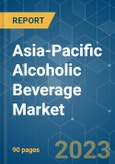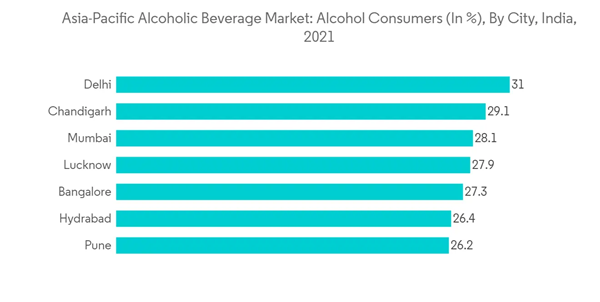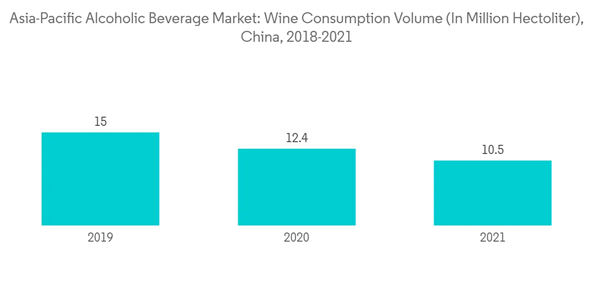The alcoholic beverage market is highly diversified in Asia because of variations in taste and preferences and social and cultural behaviors. Due to the increased demand for premium alcohol, the Asia-Pacific Alcoholic beverage market is growing steadily. Alcoholic beverages mostly appeal to millennials in Asia-Pacific who enjoy communicating over a drink without becoming inebriated. Additionally, compared to other alcoholic beverages, the 22-30 age group exhibits a substantial demand for beverages with lower alcohol concentration. Additionally, Ready drinks are popular among women as an introductory alcoholic beverage. As a result, during the coming years, these factors are expected to be important in boosting the expansion of the Asia-Pacific alcoholic beverage market.
Furthermore, factors like rapid urbanization, growing middle-class income, and higher consumer purchasing power all contribute to the rise in alcoholic beverage demand. In addition, the number of people who drink alcohol and the desire to socialize through partying and social gatherings has increased dramatically. Changing social and cultural factors have also strengthened the potential of the alcoholic beverage market. Expanding pub culture has offered more avenues for people to consume alcohol. As more and more nightclubs, bars, and pubs are prevailing around 1~ and 2-tier cities in countries like China and India, the younger generation groups have more chances to access western alcoholic beverages, thus stimulating the growth of the alcoholic beverages market in Asia-Pacific.
APAC Alcoholic Beverage Market Trends
Rising Demand for Cocktails and Other Mixed Drinks
The alcoholic beverage market is growing due to changing consumption patterns and increased disposable incomes. To meet evolving consumer tastes and preferences, alcoholic beverage makers are now introducing ready-to-mix hybrid beverages. Hybrid beverages are alcoholic cocktails that combine elements from several different beverage categories. They're made with unusual flavor combinations, ingredients, and production processes borrowed from various drinks. For example, they produce spirits or beers in a wine barrel to give them a particular flavor. In the spirit sector, hybrid beverages are especially prevalent, with products like beer blended with rum and tea mixed with vodka. Malibu Red (rum and tequila), Kahlua Midnight (rum and Kahlua), and Absolut Tune are among the most popular hybrid beverages on the market (vodka and sparkling wine).Furthermore, cocktails, mixed drinks, and shooters are the frequently featured flavored spirits in the market. The changing consumer behavior in alcoholic beverages toward flavored infused drinks is increasing the demand for flavored spirits in the market. The Indian flavor profile for alcohol have been evolved, and prefers more refined mixed alcohol in the market. Citrus, watermelon, green apple, and raspberry are considerably the most preferred flavors in assorted alcohol beverages among consumers. Flavored rum is one of the highest-consumed drinks in the market. This, in turn, encourages rum makers to introduce new flavors. For instance, in July 2021, Bacardi Limited launched Bacardi tropical, a limited-edition flavored rum in the market. The rum contains mixed tropical fruit flavors, including pineapple, coconut, and guava.
China Holds the Highest Share in the Market
China holds the largest market share in the Asia-Pacific region. The emerging nightlife culture in cities, an increasing proportion of Chinese consumers purchasing alcohol as a gift for acquaintances, and a greater willingness to try new varieties of alcohol are all driving the alcoholic beverages market in China. Furthermore, growing income levels and improvements in distribution networks and infrastructure made alcoholic beverages more accessible in the cities and boosted the demand for imported alcoholic beverages. Baijiu, the local spirit of China, is reported to witness the highest demand.The factors contributing to the market growth include increasing demand for alcoholic beverages due to the huge population base in China, coupled with the growing consumption of alcohol by the young generation. More and more international brands are targeting young consumers, by building fashionable images since they have enormous consuming potential and are willing to pay for fashionable lifestyles. In 2021, according to World Bank, 18% of the Chinese population falls in the age bracket of 0-14 years and 70% of the population falls in the age bracket of 15-64 years. According to United Nations data, the population of China is 1450.81 Million in July 2022. The consumption of spirits by the growing population is one of the major factors that contribute to market growth. According to the WTO (World Trade Centre), China is one of the largest consumers of alcohol, with an increase in per capita consumption of 0.9 liters of pure alcohol by 2025 from 2016.
APAC Alcoholic Beverage Market Competitor Analysis
The Asia-Pacific alcoholic beverage industry is consolidated, with a few companies holding the maximum market shares. Diageo Plc, Suntory Beverages & Food Limited, Bacardi Limited, Heineken Holding NV, and Anheuser-Busch InBev are the key players in the alcoholic beverage market. Product launches, followed by new mergers and acquisitions, partnerships, and expansions, are the most preferred strategies to strengthen the players' positions in the market. For instance, in January 2021, Anheuser-Busch InBev Vietnam Limited Company (AB InBev Vietnam) and SAB Beer Production Limited Company (SAB Beer) announced the official merger of SAB Beer into AB InBev Vietnam.Additional benefits of purchasing the report:
- The market estimate (ME) sheet in Excel format
- 3 months of analyst support
This product will be delivered within 2 business days.
Table of Contents
Companies Mentioned (Partial List)
A selection of companies mentioned in this report includes, but is not limited to:
- Diageo PLC
- Bacardi Limited
- Anheuser-Busch InBev
- Heineken Holding NV
- Molson Coors Brewing Company
- The Wine Group LLC
- Suntory Beverages & Food Limited
- Brown-Forman
- Radico Khaitan
- Pernod Ricard










